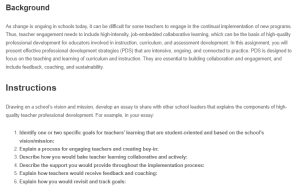Effective Learning Strategies for Curriculum Development
When engaging in the development of effective learning strategies for curriculum, instructional leadership marks the starting point. In his book “Keeping the Leadership in Instructional Leadership”, Carrier encourages principals to avoid focusing too much on operational and management roles and to actively promote a learning culture. This entails fostering the human aspect and interpersonal relations well-suited for implementing teaching methods in schools (Batista-Taran et al., 2013). In this way, by leaning towards the leadership component of the instructional leadership framework, principals can create school contexts that are characterized by high levels of learner engagement.
Another element of learning strategies is the correlation between leadership approaches and engagement levels. Using the FIU presentation by Bastia-Taran et al. as the reference, the writer notes that employees who are engaged are motivated, committed, and productive. Credible leadership approaches like transformational and servant leadership can increase engagement levels among employees (Nehez et al., 2021). When the teachers and staff members are motivated, encouraged, and have a stake in the organizational vision and mission, they are better placed to accept and put into practice new curricular techniques and strategies.
Teacher learning strategies also involve creating purposeful and meaningful professional development and learning engagements for teachers. Following the idea of Evans’ article, leaders are supposed to encourage these opportunities and provide conditions that allow teachers to grow professionally and collaborate with colleagues to develop better practices (Evans, 2014). Through constant enlightenment and improvement, leaders help teachers have the right knowledge and implement the best approach to improving the curriculum.
Additionally, the use of coaching also might be beneficial in educational contexts, according to Devine et al. (2013). Knowledge transfer is important to facilitate the implementation of research findings in the classroom, and good coaching practice can facilitate that process by strengthening teacher capacity and knowledge. This way, by implementing the use of coaching as part of the learning strategy, leaders can ensure teachers receive the necessary support and instructions to further develop the curriculum and the way of teaching.
References
Batista-Taran, L. C., Shuck, M. B., Gutierrez, C. C., & Baralt, S. (2013). The role of leadership style in employee engagement. https://digitalcommons.fiu.edu/sferc/2009/2009/1/
Carrier, L. L. (2017). Keeping the leadership in instructional leadership: Developing your practice. Routledge. https://doi.org/10.4324/9781315661520
Devine, M., Meyers, R., & Houssemand, C. (2013). How can coaching make a positive impact within educational settings? Procedia-Social and Behavioral Sciences, 93, 1382-1389.
Evans, L. (2014). Leadership for professional development and learning: enhancing our understanding of how teachers develop. Cambridge journal of education, 44(2), 179-198. https://doi.org/10.1080/0305764x.2013.860083
Nehez, J., Blossing, U., Gyllander Torkildsen, L., Lander, R., & Olin, A. (2021). Middle leaders translating knowledge about improvement: Making change in the school and preschool organization. Journal of Educational Change, 1-27. https://doi.org/10.1007/s10833-021-09418-2
ORDER A PLAGIARISM-FREE PAPER HERE
We’ll write everything from scratch
Question
Background
As change is ongoing in schools today, it can be difficult for some teachers to engage in the continual implementation of new programs. Thus, teacher engagement needs to include high-intensity, job-embedded collaborative learning, which can be the basis of high-quality professional development for educators involved in instruction, curriculum, and assessment development. In this assignment, you will present effective professional development strategies (PDS) that are intensive, ongoing, and connected to practice. PDS is designed to focus on the teaching and learning of curriculum and instruction. They are essential to building collaboration and engagement, and include feedback, coaching, and sustainability.

Effective Learning Strategies for Curriculum Development
Instructions
Drawing on a school’s vision and mission, develop an essay to share with other school leaders that explains the components of high-quality teacher professional development. For example, in your essay:
- Identify one or two specific goals for teachers’ learning that are student-oriented and based on the school’s vision/mission:
- Explain a process for engaging teachers and creating buy-in:
- Describe how you would bake teacher learning collaborative and actively:
- Describe the support you would provide throughout the implementation process:
- Explain how teachers would receive feedback and coaching:
- Explain how you would revisit and track goals:
References:
Bastia-Taran et al (2009). The role of leadership style in employee engagement [Presentation]. https://digitalcommons.fiu.edu/sferc/2009/2009/1/
Carrier, L.L. (2017). Keeping the leadership in instructional leadership: Developing your practice (1st ed.). Routledge. https://doi.org/10.4324/9781315661520
Evans, L. (2014). Leadership for professional development and learning: Enhancing our understanding of how teachers develop. Cambridge Journal of Education, 44(2), 179–198. https://doi.org/10.1080/0305764x.2013.860083
Devine, M., Meyers, C., & Houssemand, C. (2013). How can coaching make a positive impact within educational settings. Procedia-Social and Behavioral Sciences, 93, 1382-1389.
Nehez, J., Blossing, U., Torkildsen, L. G., Lander, R., & Olin, A. (2022). Middle leaders translating knowledge about improvement: Making change in the school and preschool organization. Journal of Educational Change, 1–27. doi 10.1007/s10833-021-09418-2.

